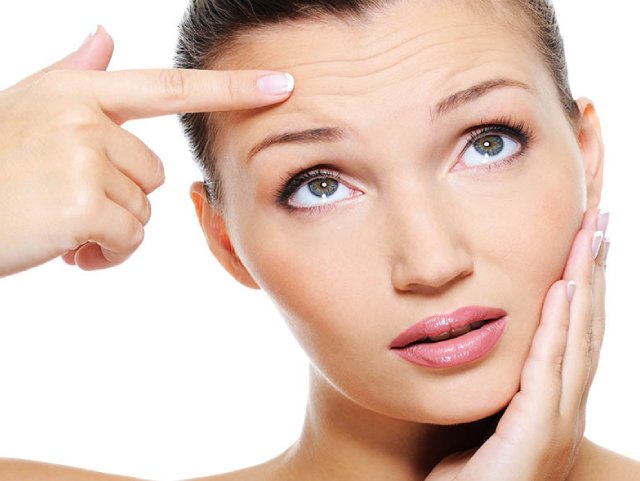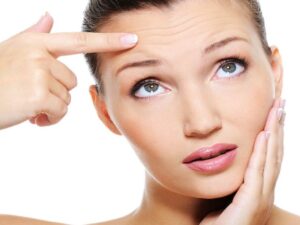1. Your pimples will go away eventually
This is not always true. Most men will outgrow their acne by their late 20s, as a man’s body does not go through many hormonal fluctuations. But a woman’s body goes through major hormonal upheavals during adolescence, later in pregnancy, and once more around the menopausal years. In fact dermatologists are increasingly seeing women who get a pimple problem for the first time in their 30s or 40s. We even see the occasional male patient who still get large painful acne in their 40s or 50s.The treatment principles remain the same, and it is worthwhile to get a hormonal evaluation done through blood tests and ultrasound scans.
2. Lip balms are addictive and regular use of lipstick will turn your lips dark
Just as your skin will feel dry if you don’t use a moisturizer regularly, your lips will get dry as well if you do not moisturize and exfoliate regularly. This myth began because a lot of individuals are allergic to the menthol, fragrance, shimmer and artificial colors added to lip balms. Such ingredients can irritate your lips leading to stinging, lip darkening and chapping. To reduce chapping, one would end up using lip balms even more frequently, creating a vicious cycle. This goes for lipstick allergies too, though the modern lipsticks we use today are mostly hypoallergenic. If you have sensitive skin or a history of allergies, then stick to bland unscented and color-free lip balms, preferably one which also has added sunscreen. These are 100% safe. Try the Sebamed, Uriage or Avene lipbalm-in-a-stick. I prefer sticks to tubes. Avoid long-lasting lipsticks as they tend to be more irritating. And apply a coat of lip balm to your lips before you apply your lipstick.
3. Toothpaste is the best remedy for pimples
This has got to be the dumbest beauty trick there ever was! Some toothpastes contain menthol or benzoyl peroxide which can reduce inflammation, but the other ingredients in toothpaste can burn and tan your skin, especially if your skin is on the duskier side. Toothpaste can only temporarily reduce the redness of a pimple, so women end up applying toothpaste frequently or else the zit is back. This is harmful and counter-productive. Toothpaste is meant to clean your teeth, which are hard and tough. Your skin is soft and sensitive and was never designed to be molested by toothpaste!
4. What worked on my friend will work for me
Not true. Your ideal skin care regime will depend on your age, level of exposure to sun/pollution and your skin type. Skin type is classified as dry, oily, combination, sensitive, resistant, pigmented, acne prone and/or mature. You need to factor in your budgetary constraints as well. Your oily-skinned friend uses a toner which works brilliantly on her, but it might irritate your sensitive skin. Your dry-skinned friend’s sunscreen makes her skin look bright all through summer, but it might give you acne. Consult a dermatologist who can analyze your skin and recommend the right products for you.
5. You can shrink your pores
Pores do not have muscles attached to them that open and close! Pores are caused by multiple factors which include oily skin, sun damage, wrong skin care products and genetics. A facial is not going to shrink pores, unless your aesthetician has used an irritant which temporary swells your skin and tightens the pores as a result. Toners, pore reduction serums, chemical peels, microdermabrasion and certain laser treatments can shrink them but most treatments are not very effective and the results are not long lasting.
6. Expensive creams work better than inexpensive ones
No, not always. It is the formulation and the ingredients which make all the difference. There are plenty of soaps, sunscreens, cleansers, moisturizers and anti-ageing creams which won’t burn a hole in your pocket but work brilliantly. Olay, Cetaphil, Dove and Neutrogena have a wide range of beautifully formulated, dermatologically tested cosmetic creams which work very well and suit most people. AND they are not frighteningly expensive. The high price of certain skin care creams is mostly on account of the brand value, the fancy packaging, import duty and expensive advertising. Some of them may indeed contain rare and exotic ingredients, but there is no reason why the mass market products would not work just as well. Go by the formulation and not the price.
7. Hair oils control hair fall and regular waxing will make your hair thinner
Hair oil can soften and condition your hair, prevent (NOT treat) split ends and moisturize your scalp. Certain hair oils may contain ingredients like henna, gooseberry, tannins and curry leaves which can prevent (NOT treat) premature hair graying. The massage has a feel-good effect and relieves stress. However the molecular weight of hair oil ingredients is too high to effectively penetrate down to the hair roots, which makes them worthless in the treatment of hair fall and balding. Any benefit you may have experienced is purely by placebo effect.
Waxing on the other hand involves plucking and tearing out of body hair from the roots. When done regularly over a period of several YEARS, some of these hair follicles may undergo sufficient permanent damage leading to thinning of the hair. So go ahead and get your legs waxed, but do it as a grooming ritual without expecting your hair to get thinner.
8. Cellulite only affects the obese
Now here’s a myth that plenty of skinny women know is untrue! Cellulite are fat deposits that get trapped between the fibrous bands that connect the skin’s soft tissues. There is a definite hormonal element because it only affects women and over 60% of all adult women suffer from cellulite in varying degrees. Cellulite makes its first appearance in the late teen years and gets worse during pregnancy or if there has been rapid weight gain or weight loss. Exercise, adequate water intake and a no-alcohol and low-sodium diet can help you get rid of unsightly cellulite. Regular massages prevent cellulite build up. Until then, skin firming creams can tighten your skin, a good tanning lotion can hide cellulite, and certain fat dissolving lasers and local injections can improve the appearance of cellulite. But cellulite can always come back unless you keep working at it.
9. Coloring your hair can turn them gray
I am not sure how this rumor got started but I’m guessing this is a story mums feed their teenaged kids to get them to stop coloring their hair! Hair coloring involves use of a permanent dye to change the color of the hair shaft. It does not penetrate deep down to the hair roots, and it is not capable of bleaching it. Gray hair is a result of a complex interplay of genetic timing, nutritional deficiencies, sun damage and/or emotional shock. Frequent hair coloring does have some adverse effects which include dry and damaged hair, an irritable scalp, eye watering and facial pigmentation. But hair graying is not one of them. So go ahead and color your hair to cover those grays.
10. Dandruff can be cured using anti-dandruff shampoo
Dandruff can be effectively controlled and eliminated using an anti-dandruff shampoo. Doctors today have a whole range of various anti-dandruff ingredients which work on all kinds of dandruff; be it mild flaking, itchy greasy yellow scales or the stubborn scaling of psoriasis. But since dandruff is controlled by your genes, genetics and environment, it is impossible to CURE dandruff for good. This may shock most of you, but it is true- medical science still does not have a cure for something as simple and widespread as dandruff! Use your anti-dandruff shampoo regularly to avoid a recurrence.




